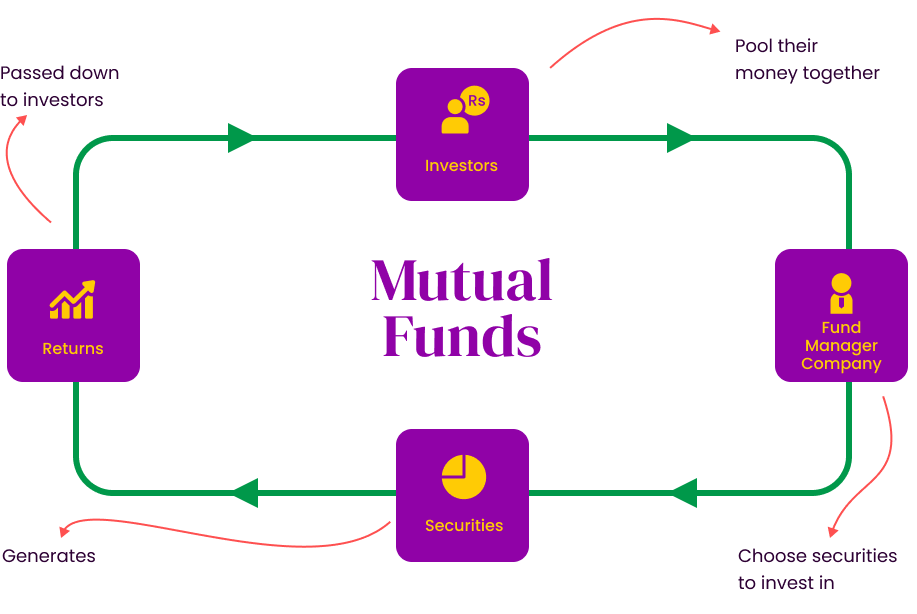Equity Funds
Objective
The objective of equity funds is long-term growth of capital by investing in stocks.
Risk
Because stocks are generally more volatile than other type of investments, equity funds (which are usually composed entirely of stocks) may exhibit short-term fluctuation and therefore carry a higher level of risk. Investors need to be prepared to tolerate this higher risk. Equity funds could be a good investment if you have a long-term perspective and can stay invested for at least three years or perhaps even longer.
Types Of Investments
Equity funds primarily invest in stocks of companies as per the investment objective and philosophy.
Balanced Funds
Objective
The objective of balanced fund is to generate long term capital appreciation as well as current income from a portfolio comprising of both equity as well as fixed income securities.
Risk
Balanced funds which have a combination of both equity and fixed income instruments, tend to provide investors with a moderate level of risk exposure. Balanced funds are ideal for those looking for income and growth over medium to long-term investment horizon.
Types Of Investments
Balanced funds primarily invest in equities as well as in fixed income instruments.
Index Tracker Funds
Objective
The objective of index tracker funds is to provide investors an opportunity to track closely the performance of an Index by investing in proportion to the constituent securities found in the index. Being a passive fund, it charges lower management fee from unit holders vs. a pure equity active fund.
Risk
The Fund is suitable for investors who may simply wish to mirror the risk and return profile that is achieved by investing in any particular index.
Index Funds that track an equity index, simply aim to mirror the return of the subject index. It must be noted that these are risky investments, since the underlying securities are usually equity securities with their inherent volatility intact. However, the fund manager has no discretion on the choice of security, other than to passively invest in the constituent equity securities in the weightages, as found in the subject index.
Types Of Investments
Index funds are 100% replica of a particular index.
Income Funds
Objective
The objective of income funds is to have a regular stream of income by investing in debt securities that have the potential to provide a higher level of regular income than money market funds and may also generate reasonable capital growth.
Risk
Fixed income funds are usually safer investment avenues than stock funds, but maybe slightly more riskier than money market funds. As is the case with other Fixed Income securities, their prices and performance is heavily dependent on the level and change in interest rates (and other market conditions). These are usually suitable for investors who want to avoid the high volatility experienced in the stock market.
Types Of Investments
Fixed income funds primarily invests in Govt. Securities, Banks, Sukuks, TFC, TDR, CFS, Certificate of Musharka, Spread Transactions etc.
Money Market Funds
Objective
The objective of money market funds is to invest in low risk avenues.. These funds aim to preserve your original investment and achieve target returns with high certainty and low risk factor by investing in investment instrument with low risk and lower volatility.
Risk
Money market funds are considered fairly safe and appropriate for investors who want to limit risk or who are investing for a short period of time and want ready access to their money. Money market funds have very low risk of losses in principal invested along with higher certainty of target return achievement.
Types Of Investments
Money Market funds primarily invests in highly rated Govt. Securities, Banks, Sukuks, TFC, TDR, CFS, Certificate of Musharka, etc
Asset Allocation Funds
Objective
The objective of an asset allocation fund is to generate returns by investing in a mix of equity and debt securities (or any other asset class that may be included as well).
Risk
Asset allocation funds are suitable for investors who have the comfort on the fund manager to prudently switch between the various asset classes, as per market outlook.
Types Of Investments
Asset Allocation funds usually shift their exposures between debt and equity (and/or any other asset class) as per the outlook on the market.
Capital Protected Funds
Objective
The investment objective is to protect Initial Investment Value along with the prospect of growth upon the initial investment over the stipulated time period.
Risk
Capital protected funds are suitable for investors who do not wish to take any significant risk and are seeking the potential for improved returns above those available on money market/debt funds or bank deposits. They seek participation to equity markets with the assurance that their initial principal is protected or safeguarded.. Feature of capital protection is normally offered if the investment is held till maturity.
Types Of Investments
Capital protected funds give you 100% capital protection, with the potential to earn a return that is better than that being offered by bank deposits or money market funds/ instruments. In order to achieve their objective they may seek to cash-in on any stock market upside that may be witnessed during the tenure.
Voluntary Pension Funds
Objective
The investment objective is to provide participants a regular income at the time of retirement and at an age when one’s capacity to work is diminished, so that one is not dependant on other members of the society.
Risk
Voluntary Pension schemes in Pakistan normally have 3 sub- funds and based on these sub-funds offer various attractive allocation schemes. Each scheme may carry a varying level of risk. For a participant investment risk range from low to high (depends on the chosen asset allocation).
Types Of Investments
Investor can choose from a wide range of investment options depending on retirement goals, age and appetite for risk. Contributions will be invested in the particular scheme.
Exchange Traded Fund
Objective
Meezan Pakistan Exchange Traded Fund is a Shariah Compliant Exchange Traded Fund that aims to provide investors an opportunity to track the performance of Meezan Pakistan Index that has been constituted and is maintained by the Management Company, and comprises of Shariah compliant equity securities selected with high consideration towards market capitalization and traded Value.
Risk
Exchange Traded Funds are suitable for investors who have the ability to take the risks associated with financial market investments.
Types Of Investments
The Index will consist of selected liquid stocks in accordance with KMI-30 index, which will be derived through the security selection criteria, in order to achieve the investment objective. The Management Company shall aim to maintain an aggregate number of 12 stocks in the Benchmark Index, if the below-mentioned criteria permit.
Fixed Term Funds
Objective
The objective is to provide investors with a competitive rate of return, for fixed tenure by investing primarily in Shariah Compliant TDRs and money market placements / Instruments for a specific duration.
Risk
Very Low
Exchange Traded Funds are suitable for investors who have the ability to take the risks associated with financial market investments.
Types Of Investments
Fixed Term Funds primarily invest in Shariah Compliant TDRs and money market placements / Instruments for a specific duration.
Islamic Commodity Funds
Objective
Aims to provide maximum exposure to prices of Gold in a Shariah Compliant (Islamic) manner, by investing a significant portion of the Fund’s net assets in deliverable gold based contracts available on Pakistan Mercantile Exchange (PMEX).
Risk
High
Exchange Traded Funds are suitable for investors who have the ability to take the risks associated with financial market investments.
Types Of Investments
Islamic Commodity Funds primarily invest significant portion of the Fund’s net assets in deliverable gold basedcontracts available on Pakistan Mercantile Exchange (PMEX).


















